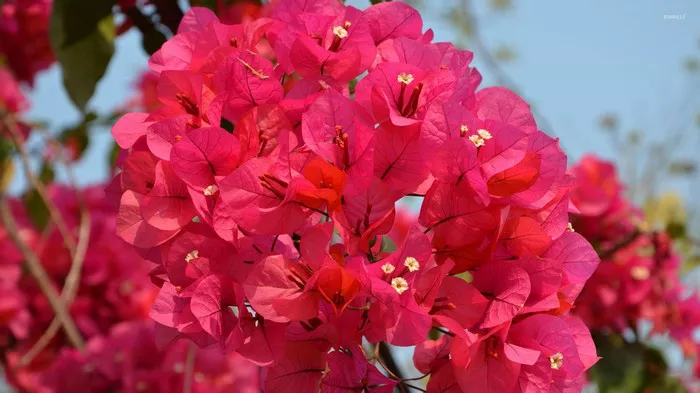Bougainvillea, renowned for its vibrant and captivating blooms, is a beloved ornamental plant gracing gardens worldwide. While admired for its beauty, a lesser-known aspect of this plant is its potential culinary use. In this article, we delve into the intriguing realm of bougainvillea flowers, examining their edibility, nutritional value, and offering tantalizing recipes to unlock their gastronomic potential.
Edibility of Bougainvillea Flowers
The question of whether bougainvillea flowers are edible is a common inquiry among enthusiasts of both gardening and gastronomy. While the vibrant hues of bougainvillea blossoms may suggest an enticing appeal, it’s crucial to ascertain their safety for consumption.
Bougainvillea flowers are indeed edible, but with a caveat. While the flowers themselves are generally safe to eat, caution must be exercised due to the presence of potentially harmful substances. Bougainvillea plants contain mildly toxic compounds, including saponins and oxalates, which can cause gastrointestinal discomfort if ingested in large quantities. Therefore, moderation is key when incorporating bougainvillea flowers into culinary creations.
It’s essential to harvest bougainvillea flowers from organic, pesticide-free sources to ensure their safety for consumption. Thoroughly wash the flowers before use to remove any dirt, insects, or residues that may compromise their edibility.
Nutritional Value of Bougainvillea Flowers
Beyond their aesthetic appeal, bougainvillea flowers offer a surprising array of nutritional benefits. While not a staple food source, these blooms contribute a modest yet noteworthy nutritional profile to culinary dishes.
Bougainvillea flowers are rich in vitamins and minerals, including vitamin C, vitamin A, and various B vitamins. They also provide dietary fiber, which supports digestive health and promotes satiety. Additionally, bougainvillea flowers contain antioxidants, such as flavonoids and phenolic compounds, which help combat oxidative stress and inflammation within the body.
Despite their nutritional value, bougainvillea flowers are not typically consumed in large quantities, so their contribution to overall nutrient intake may be relatively minor. However, incorporating these flowers into a diverse and balanced diet can provide a unique source of vitamins, minerals, and antioxidants.
Recipes Featuring Bougainvillea Flowers
Now that we’ve explored the edibility and nutritional value of bougainvillea flowers, let’s embark on a culinary journey to discover delightful recipes that showcase their beauty and flavor.
1. Bougainvillea Flower Salad:
Ingredients: Fresh bougainvillea flowers, mixed greens, cherry tomatoes, cucumber, red onion, feta cheese, balsamic vinaigrette.
Instructions: Wash and dry bougainvillea flowers and mixed greens. Combine with sliced cherry tomatoes, cucumber, and thinly sliced red onion. Crumble feta cheese over the salad and drizzle with balsamic vinaigrette. Garnish with whole bougainvillea flowers for a colorful and vibrant presentation.
2. Bougainvillea Flower Infused Water:
Ingredients: Fresh bougainvillea flowers, filtered water, ice cubes.
Instructions: Rinse bougainvillea flowers and place them in a pitcher filled with filtered water. Allow the flowers to infuse the water for several hours or overnight in the refrigerator. Serve chilled with ice cubes for a refreshing and visually stunning beverage option.
3. Bougainvillea Flower Sorbet:
Ingredients: Fresh bougainvillea flowers, sugar, water, lemon juice.
Instructions: Prepare a simple syrup by heating water and sugar until dissolved. Remove from heat and add fresh bougainvillea flowers, allowing them to steep for 10-15 minutes. Strain the infused syrup and mix with freshly squeezed lemon juice. Pour the mixture into an ice cream maker and churn according to manufacturer instructions until frozen. Serve the bougainvillea flower sorbet in elegant bowls garnished with additional blossoms.
These recipes offer just a glimpse into the culinary possibilities of bougainvillea flowers. With creativity and culinary finesse, these vibrant blooms can elevate dishes with their visual appeal and delicate flavor profile.
Conclusion
In conclusion, bougainvillea flowers present a fascinating intersection of beauty and culinary potential. While their edibility should be approached with caution due to the presence of mild toxins, when harvested and prepared correctly, these blooms offer a unique addition to culinary creations. With their modest nutritional value and captivating aesthetic, bougainvillea flowers have the potential to enchant both the palate and the senses. So, the next time you encounter a profusion of bougainvillea blooms, consider embracing their culinary allure and exploring the myriad ways to incorporate these floral gems into your culinary repertoire.


